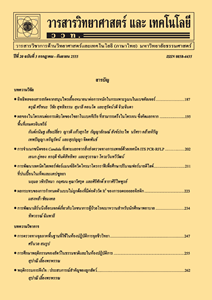สมดุลความปลอดภัยระหว่างความต้องการของงานกับความสามารถในการทำงานของคนงานก่อสร้างอาคารสูง
Main Article Content
Abstract
บทคัดย่อ
งานก่อสร้างประกอบไปด้วยงานที่มีกิจกรรมหลากหลายและสลับซับซ้อน อีกทั้งมีสภาพแวดล้อมการทำงานที่เปลี่ยนแปลงไปตามเงื่อนไขและข้อกำหนดของแต่ละโครงการ ส่งผลให้มีโอกาสในการประสบอุบัติเหตุสูงขึ้นและทำให้ความเสี่ยงในการประสบอุบัติเหตุเปลี่ยนแปลงตามไปด้วย จึงจำเป็นต้องมีการจัดการบริหารงานบุคคลหรือแรงงานก่อสร้างให้เหมาะสมและสมดุลกับงานที่ได้รับผิดชอบ งานวิจัยนี้เป็นการนำเสนอแบบจำลองสมดุลความปลอดภัยในงานก่อสร้าง (construction safety equilibrium model) ระหว่างความต้องการของงาน (task demand) กับความสามารถในการทำงาน (capability) โดยใช้แบบจำลองการเกิดอุบัติเหตุบนท้องถนนเป็นพื้นฐานในการพัฒนาแบบจำลอง ทำการศึกษาปัจจัยต่าง ๆ ที่มีผลต่อความต้องการของงาน และความสามารถในการทำงาน พร้อมทั้งนำเสนอน้ำหนักแต่ละปัจจัยด้วยวิธีการวิเคราะห์เชิงลำดับขั้น (analytic hierarchical process, AHP) โดยการสัมภาษณ์เจ้าหน้าที่ความปลอดภัยในงานก่อสร้าง จากนั้นจึงนำแบบจำลองที่สร้างขึ้นไปทดลองใช้กับกลุ่มตัวอย่างคนงานก่อสร้างอาคารสูงที่มีประวัติการเกิดอุบัติเหตุระหว่างการทำงานในอดีตที่ผ่านมาจำนวน 15 ราย ผลจากการวิจัยพบว่า (1) ปัจจัยหลักที่มีน้ำหนักมากที่สุดสำหรับความต้องการของงาน คือ ปัจจัยพฤติกรรมการทำงาน (work behavior factor) โดยปัจจัยย่อยด้านกฎความปลอดภัยในโครงการ เป็นปัจจัยที่มีความสำคัญสูงที่สุด ส่วนความสามารถในการทำงานนั้น ปัจจัยหลักที่มีน้ำหนักมากที่สุด คือ ปัจจัยด้านมนุษย์ (human factor) โดยมีปัจจัยย่อยที่มีความสำคัญสูงสุดคือ ความหงุดหงิดของจิตใจ (2) ระดับความต้องการของงาน (task demand level) เฉลี่ยของกลุ่มตัวอย่างมีค่าอยู่ที่ 1.99 โดยที่ค่าระดับความสามารถในการทำงาน (capability level) อยู่ที่ 1.77 จากคะแนนเต็ม 3.00 หมายความว่างานที่กลุ่มคนงานกำลังปฏิบัติงานแล้วประสบอุบัติเหตุนั้นเป็นงานที่ยากเกินกว่าความสามารถคนงานในการทำงาน โดยผลดังกล่าวสอดคล้องกับหลักการสมดุลความปลอดภัยในงานก่อสร้าง
คำสำคัญ : ความปลอดภัยในงานก่อสร้าง; สมดุลความปลอดภัย; ความต้องการของงาน; ความสามารถในการทำงาน
Abstract
Construction work involves a large number of work processes and also unpredictable environment that needs to adapt by project requirements and context. These things create more chances of accident and variation of risks, and require the workforce resource management to balance between task demand and capability of workers and adapt to the changing situation. This research proposed the construction safety equilibrium model of task demand and capability which is based on the car accident model. This study investigated the factors that influence on task demand and capability and also determined the weight of each factor by analytic hierarchical process via interviewing construction safety officers. The 15 accident case studies of workers who worked in high-rise building construction projects were applied for the validation of the model. The results come up with (1) the highest weight of the main factor of task demand contributes to work behavior factor and rule of safety is the mostly weighted sub-factor; for capability, the dominant main factor is human factor and frustration is for the sub-factor. (2) The overall average task demand level and capability level of the group sample is 1.99 and 1.77 of the 3.00 point interval. These scores can reflect the works that workers were doing during suffering accidents were more difficult than the workers’ capability according to the principle of construction safety equilibrium.
Keywords: construction safety; safety equilibrium; task demand; capability


